
Obtaining Food at Sea Menu: 1 2 3 4 5 6 7 8 9 10 11 Next>>
Obtaining Food at Sea During the Golden Age of Piracy, Page 6
Obtaining Food at Sea in the Late 17th and Early 18th Centuries - Buying vs Trading
Purchasing Food By Bartering
Bartering was a often used by sailors for procuring food, especially in more remote locations where
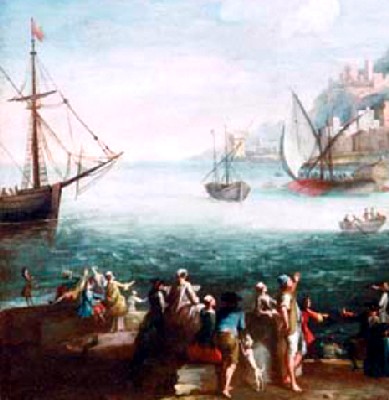
Artist: attributed to Adriaen van der Cabel - Mediterranean Port (17th Century)
money was not particularly useful. Among the things traded by sailors with natives for food, four occur frequently: cloth/clothing, alcohol/tobacco, weapons/tools and other metal items. Such things would have had utility to more rustic populations and would be somewhat difficult for them to produce themselves. In addition to items which fit into these four categories, there were other items of interest used for bartering which are placed into a fifth category.
There are 7 citations which mention using cloth or clothing for trade. Two of them come from John Baltharpe's poem about the voyage of HMS St. David in the Mediterranean during 1669-71. Visiting Livorno in January of 1670, Baltharpe says that the navy sailors usually spent their money until it ran out after which the Italians would "run about [asking for] old Coat, old Breech[es]"1. When the St. David stopped at Messina in May of the same year, Baltharpe similarly says, "When Moneys gone, they'l [the Italians will] truck [trade] for bread [and wine and other food], No more needs now for to be said, Old a Drawers, old a Wascoate"2.
Italy could hardly be considered a remote location and money was clearly preferred to trades as Baltharpe explains, but when the Italians
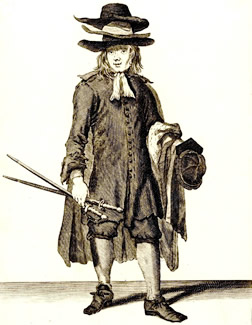
Artist: Marcellus Laroon
Second-Hand Clothes Street Vendor
From The Cryes of City of London (1688)
had managed to get all the money they could from the English Navy men, they'd trade for cloths since second-hand clothing was considered more valuable during this period than it is today. Ed Fox explains in his doctoral dissertation on piracy, "clothing was a valuable commodity and so constituted a form of portable wealth, the worth of which could be realised in almost any legitimate community"3.
This actually presented an opportunity for a ship's purser to make money since he managed the ships slops chest which contained clothing that could be sold to the men on a long voyage when theirs wore out. While aboard HMS Yarmouth in 1668, Edward Barlow explains how when at Malaga, Spain. He says that the sailors would drink the local wine
as long as they can procure one penny, for always the pursers of His Majesty's ships carry out of England with them all manner of clothes for seamen to sell to the men of the ship if they want them in the term of the voyage, setting it upon their score to pay for them when the ship is paid: and the poor seamen, wanting money, go to the purser and there take up such clothes as they think will yield the most money, setting their hand to the purser's [record of sales] book to pay at pay-day ten shillings for that which costeth in England seven, and going ashore with it sell it to the Spaniards or to any other people where they are, for four or five shillings, many taking up all their wages in this manner4
To simplify Barlow's explanation, the sailors would buy clothing from the purser's slop chest worth 7£ for 10£, putting the purchase price against their future pay (navy sailors paid at the end of a voyage) and then sold the clothing they had just bought to the Italians for about 1/2 what they paid. The proceeds could then be spent on drink. Barlow tends to be cynical, so without supporting documentation, it is wise to take the
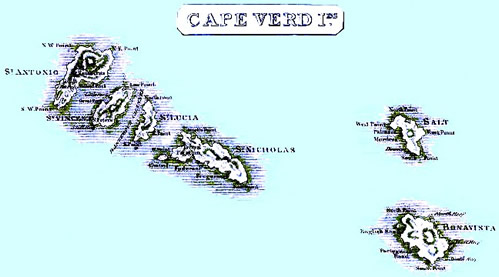
Cartographer: John Thomson - Northern Cape Verde Islands (1814)
amounts presented with a grain of salt, but there is almost certainly truth to his assertion.
In the account of his privateer voyage to South America, Woodes Rogers mentions the tendency of sailors to barter their clothing in exchange for alcohol and native bartered items twice. The first is a rather offhand comment, with Rogers musing, "our Men [were] but meanly clad, yet good Liquor to Sailors is preferable to Clothing."5 The second comment is much more explicit, recorded following a stop at the Cape Verde Islands where Rogers explains that the officers of the Duke and Dutchess were "forc'd to watch our Men very narrowly, and punish several of 'em, to prevent their selling what Clothes they have for Trifles to the Negroes, that came over with little things from St. Antonias [modern Ilha de Santo Antão]."6
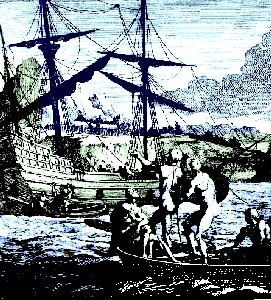
Natives Trading, From Versameling der Gedenk-
Waardigste
zee en Land-Reysen, vol 15, p. 52 (1706)
The rest of the examples of trading cloth and clothing come from native populations in Africa and the East Indies. Sea surgeon John Atkins presents two examples of African natives trading food for clothing to sailors on HMS Swallow in 1721-22. At Cape Montzerado (modern Monrovia, Liberia) he says that the natives traded for "old Breeches, Shirts, Rags... and whatever else they saw"7 and at Cape Lopez (modern Gabon) they offered goats, fowl and honey, "exchanged with us on easy terms, for Linnen, Calicos, [and other fabric] Stuffs"8. When the East India Company ship Salisbury was at Santiago in the Cape Verde Islands in 1721, midshipman Clement Downing advised that there "were Fowls, Coconuts, Plantanes, Bananas, Pine-Apples, Hogs, and some Goats; which the Natives barter for any sort of old Clothes."9 In the same year, the ship anchored on the opposite side of Africa at Anjouan in the Comoros Islands where he likewise says that the natives would barter "for any manner of old Clothes"10. The last example comes from Edward Cooke, who was at Pulau Buton, Indonesia in March of 1710 about the Dutchess where the locals approached the ship offering food in exchange for "clothing".11
Several accounts mention tobacco and, to a lesser degree, alcohol as useful trading commodities. Tobacco was valued at several locations outside of the Americas. Sailor Alexander Hamilton said that the people on Nancowry Island, India "are very greedy of [tobacco], for a Leaf of Tobacco, if pretty large,
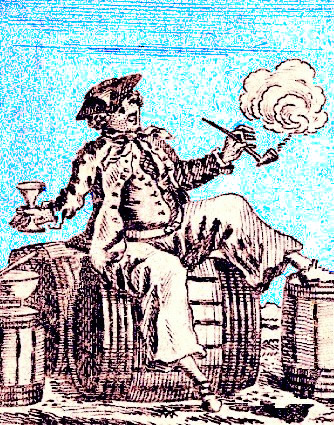
Sailor smoking, From a Tobacco Paper for Newmans Best
Virginia Tobacco, British Museum (18th Century)
they will give a Cock [rooster]"12. While at Texel, Netherlands in 1675 on the merchant vessel Fflorentine, Edward Barlow reported that "the country people, which were Danes, came aboard to see us... and... for two or three pipes of [tobacco], they would give us four or five great lobsters"13. John Atkins also mentions tobacco and pipes being used to trade for provisions. He says that "a fat Fowl for a Span of Brazil Tobacco, (no other Sort being valued)" at São Tomé, Príncipe, and Annobón when the Swallow was there in January, 1722. Atkins also talks about the natives trading for tobacco pipes both along the Gold Coast of Africa (near Ghana) during that year14 and at Sesthos (Cape Palmas, Liberia.)15
Alcohol was found as a trade item less frequently in the sailors accounts from around this period. This may be due to the fact that it was used as an opening offering to encourage those with whom the sailors wished to trade. However, there are a few examples of alcohol as a trade commodity. Surgeon Johann Dietz reveals that "we gave [the inhabitants of Iceland] brandy and tobacco from our small store, which to them was highly acceptable. In return they brought us reindeer milk and cheese, dried fish and smoked eel and salmon, a considerable quantity of furs, and some whalebone and other matters" during the late 17th century.16 While sailing at Gravesend in England in July of 1677 in his small merchant boat, captain Jeremy Roch met a fisherman who "treated us with fish and we filled his head and guts with drink"17. This was apparently just a marriage of convenience as either party could have gotten the same products on shore. Being the only example of trading nothing but alcohol for food, it again suggests the limited value it had.
Weapons and tools would have been particularly useful to
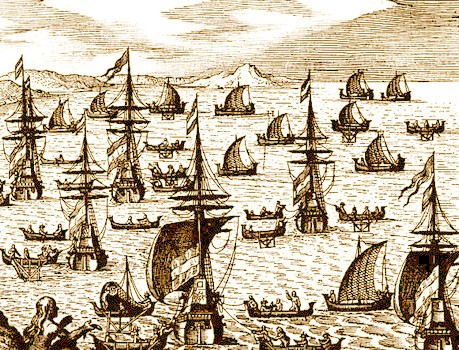
Artists: Theodor and Johann de Bry -
Natives Trading in the Ladrones [Marianas Islands] (1614)
primitive people who had limited ability to make or procure them. They are mentioned being used to trade for provisions in 8 different places. It is important to differentiate between implements that were traded for their usefulness as tools and weapons and those which were just metal objects that the traders wanted for melting down forming them into other objects. For example, William Dampier explains that the Batane island of Itbayat, the locals traded alcohol for "old Nails, Spikes, and Leaden Bullets."18 Based on his description and the other items in the list, it is fairly apparent that the bullets were likely to be used for some other purpose than their original design.
John Atkins mentions tools and weapons being used to trade for food when aboard HMS Swallow in 1722 on the African west coast at Sesthos (Cape Palmas, Liberia), Cape Lopez in modern Gabon and at São Tomé, Príncipe, and Annobón.19 The first two are fairly reasonable examples of the tool itself being of use. At Sesthos, he mentions among other things that powder and shot was traded for food, so their function as weapons seems fairly straightforward. Pewter spoons and knives were desired at Cape Lopez, probably for their function as utensils. At the Portuguese Islands, however, he simply says that a sailor could get "A good Hog for an old Cutlash"20. In an absence of other information, this is taken to mean that the cutlass had value as a cutlass to the islanders.
Supporting the notion that the natives on these islands had use for weapons, William Phillips said that when Henry Every's ship Fancy anchored at Annobón in 1694, the pirates "took in more water and Oranges and about fifty hogs which we paid for part money, part small arms."21 After rounding the Horn of Africa, they stopped at Madagascar during the same year where "we bought about 100 bullocks for powder and small arms."22 The native of Madagascar were frequently at war with each other, sometimes even enlisting the aid of the pirates, so such weapons would have given them a distinct advantage in their battles with other tribes.
Several accounts mention trading knives for food. Privateer
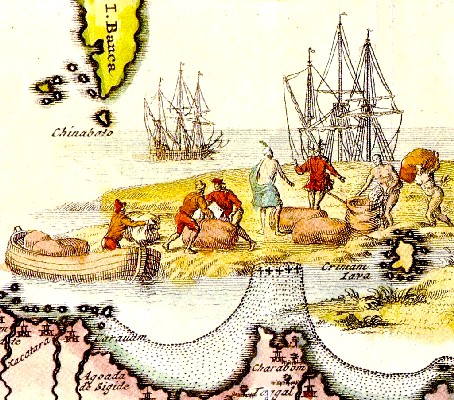
Dutch Trading with Natives of Java, From a Map of North Coastal Ports of Java, (early 18th)
Edward Cooke says that when the Dutchess was at Java Head (Tanung Layar in West Java) in October, 1710, they could "buy Fowls and fresh Provisions, which the Natives exchange for Knives and Toys"23. Five months earlier he explained that when the ship stopped at Pulau Buton in Indonesia, "the Inhabitants came off with Indian Corn, Coco-Nuts, Patats, Papas [Paw paws], Hens, and pretty Indian Birds, to truck [trade] for Cloaths, Knives, Scissars, &c."24 Edward Barlow similarly notes that when the merchant vessel Scepter was in Balacala (Belekeri, India) in 1697, fishermen "brought abundance of fresh fish aboard, which we bought for knives, scissors, and small trifling things, giving all our men as much fish as they could eat."25 While knives might have been used as weapons, two accounts have them being traded with scissors and a third includes them with pewter spoons, suggesting that their utility as a tool was probably at least as important, if not more important, than their use as a weapon.
As mentioned, metal itself had value to traders, particularly those in the Orient who exchanged it for food. Father Domingo Navarette said that when the merchant vessel on which he was a passenger reached the Philippines, "A small Vessel made up to us; we lay by for it, to take in
, Encylopedie, Denis Diderot, 1763.jpg)
Heavy Nail Maker (Cloutier), From Encyclopédie, by Denis Diderot (1763)
some Refreshment it likely brought, which the Natives of those Islands [Philippines] exchange for Nails and old Iron."26 When William Dampier reached 'Orange Island' (modern Itbayat, Batane Islands) in the Philippines in August of 1687, he likewise reported that "for an old Iron Hoop, and a Hog of seventy or eighty Pound weight for two or three Pound of Iron" as well as nails, spikes and bullets as already explained.27 Ever interested in the intricacies of life in different places, Dampier gives insight into how the sailors responded to this thirst for metal items by the locals. "It was one Man’s Work to be all Day cutting out Bars of Iron into small Pieces with a cold Chisel: And these were for the great Purchases of Hogs and Goats, which they would not sell for Nails, as their Drink and Roots. We never let them know what Store we have, that they may value it the more."28 Fellow buccaneer William Cowley reached Guam in 1684, where he found that the island inhabitants "came on board us, and brought us Potatoes, Monanoes, Cocoa Nuts and Plantans, selling them to us for old Nails and old Iron"29.
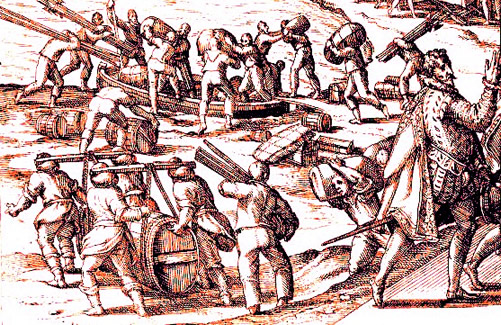
Artist: Theodor de Bry
Sailors Loading Supplies on Boats, From
Americae, pt 6 (1597)
The last example of metal being traded by sailors with locals in the orient for food comes from Hamilton's stop at Nancowry Island, India. He says, "The People come thronging on board in their Canoaes, and bring Hogs, Fowl, Cocks, Fish, fresh, salted and dried Yams, the best I ever tasted, Potatoes, Parots and Monkies, to barter for old Hatchets, Sword-blades, and thick Pieces of Iron-hoop... for three Foot of an Iron Hoop, a large Hog, and for one Foot in Length, a Pig."30 Hamilton's account does mention tools and weapons, but he refers to them as 'old' and specifically states that the blades of swords were wanted, suggesting that the people wanted these items more for their metal content than their intended function. Although it is not detailed, the metal was probably being melted down by the people on land and forged into other items.
The final category of items traded for provisions includes anything which doesn't fit in the other four categories.

Artist: Jacob Koppmayer
Trading at Surat, From Delineatio provinciarum Pannoniae (1687)
Some of these things were very vague like the already discussed 'toys' Cooke talked about when the Dutchess was at West Java and 'small trifling things' Barlow mentioned when the Scepter was at Belekeri, India. Two of John Atkins's stops while aboard the HMS Swallow in Africa provide more detail on such 'other' items. When they were sailing along the African Gold Coast in 1721, they used sealing wax to open up trade with the natives.32 Even more interesting, in May of 1721, he noted that "it is common to bring your Traffick; brass Pans, pewter Basins, Powder, Shot, old Chests, &c. and exchange for Rice, Goats and Fowls. ...A 2 pound Basin buys a Goat; and I purchased two for an old Chest, with a Lock to it."32
At some places, items we think of as food could be traded for food. Atkins explains that at Cape Montzerado in 1721, the locals traded local food for ship's biscuit.33 When Clement Downing was aboard a small vessel off Bombay in 1716, he traded rice or salt with local fishermen for their catch.34 George Shelvocke's privateer ship Speedwell was at Santa Caterina Island in Brazil in 1719, where he said "the inhabitants came off to us every day, with the product of the place, which I purchased with salt as long as I had any to spare."35 Salt was particularly important for its use as a preservative and was in demand during this period. Another spice appears when the Salisbury arrived at Anjouan of the Comoros Islands in July of 1721' Clement Downing says that the residents there traded food and water for pepper.36
1 John Baltharpe, The Straights Voyage, or, St. Davids Poem, 1671, p. 32; 2 Baltharpe, p. 40; 3 Ed Fox,'Piratical Schemes and Contracts, 2013, p. 83; 4 Edward Barlow, Barlow’s Journal of his Life at Sea in King’s Ships, East and West Indiamen & Other Merchantman From 1659 to 1703, 1934, p. 151-2; 5 Woodes Rogers, A Cruising Voyage Round the World, 1712, p. 11; 6 Woodes Rogers, p. 26; 7 John Atkins, A Voyage to Guinea and Brazil, 1735, p. 58; 8 Atkins, Voyage... p. 197; 9 Clement Downing, A Compendious History of the Indian Wars, 1737, p. 79; 10 Downing, p. 82; 11 Edward Cooke, A Voyage to the South Seas, 1712, Vol. 1, p. 449; 12 Alexander Hamilton, British sea-captain Alexander Hamilton's A new account of the East Indies, 17th-18th century, 2002, p. 419; 13 Barlow, p. 254; 14 John Atkins, From Charles Johnson, A General History of the Pyrates, Manuel Shonhorn, ed., 1999, p. 179; 15 Atkins, Voyage... p. 63; 16 Johann Dietz, Master Johann Dietz, Surgeon in the Army of the Great Elector and Barber to the Royal Court, 1923, p. 139; 17 Jeremy Roch, from Bruce S. Ingram, Three Sea Journals of Stuart Times, 1936, p. 93; 18 William Dampier, A New Voyage Round the World, 1699, p. 435; 19 Atkins, Voyage... p. 63 & 197 & Atkins, General History, p. 179; 20 Atkins, General History, p. 179; 21 “2. William Phillips The Voluntary Confession and Discovery of William Phillips, 8 August, 1696. SP 63/358, ff. 127-132”, Pirates in Their Own Words, Ed Fox, ed., 2014, p. 24; 22 “2. William Phillips...", p. 25; 23 Cooke, p. 449; 24 Cooke, p. 451; 25 Barlow, p. 491; 26 Domingo Navarrete, The Travels and Controversies of Friar Domingo Navarrete 1618-1686, 1962, p. 40; 27,28 Dampier, p. 435; 29 William Ambrosia Cowley, "Cowley’s Voyage Round the Globe", A collection of original voyages, William Hacke, ed., 1993, p. 435; 30 Hamilton, p. 374; 31 Atkins, Voyage... p. 159; 32 Atkins, Voyage... p. 63-4; 33 Atkins, Voyage... p. 58; 34 Downing, p. 24; 35 George Shelvocke, A Voyage Round the World by Way of the Great South Sea, 1726, p. 19; 36 Downing, p. 82

